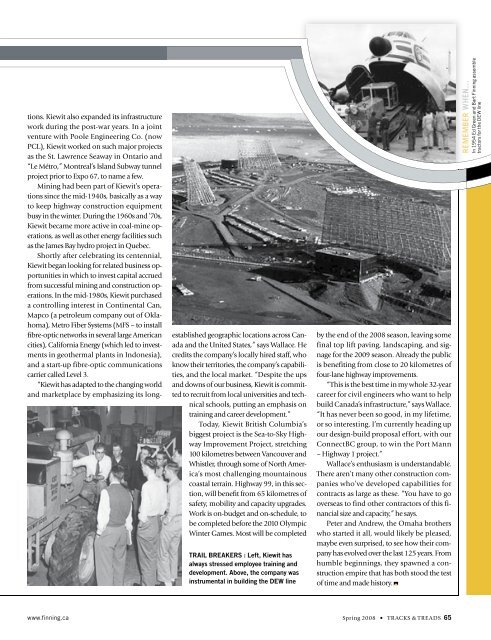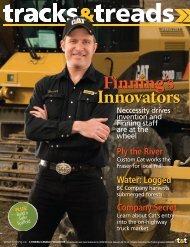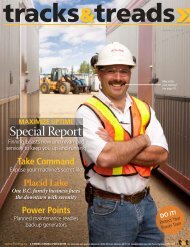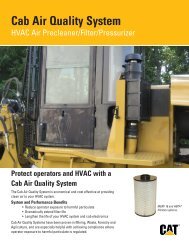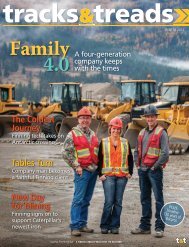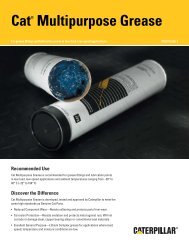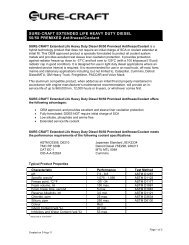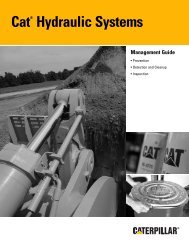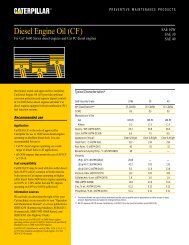Everyday Heroes: Meet Finning's service ... - Finning Canada
Everyday Heroes: Meet Finning's service ... - Finning Canada
Everyday Heroes: Meet Finning's service ... - Finning Canada
You also want an ePaper? Increase the reach of your titles
YUMPU automatically turns print PDFs into web optimized ePapers that Google loves.
tions. Kiewit also expanded its infrastructurework during the post-war years. In a jointventure with Poole Engineering Co. (nowPCL), Kiewit worked on such major projectsas the St. Lawrence Seaway in Ontario and“Le Métro,” Montreal’s Island Subway tunnelproject prior to Expo 67, to name a few.Mining had been part of Kiewit’s operationssince the mid-1940s, basically as a wayto keep highway construction equipmentbusy in the winter. During the 1960s and ’70s,Kiewit became more active in coal-mine operations,as well as other energy facilities suchas the James Bay hydro project in Quebec.Shortly after celebrating its centennial,Kiewit began looking for related business opportunitiesin which to invest capital accruedfrom successful mining and construction operations.In the mid-1980s, Kiewit purchaseda controlling interest in Continental Can,Mapco (a petroleum company out of Oklahoma),Metro Fiber Systems (MFS – to installfibre-optic networks in several large Americancities), California Energy (which led to investmentsin geothermal plants in Indonesia),and a start-up fibre-optic communicationscarrier called Level 3.“Kiewit has adapted to the changing worldand marketplace by emphasizing its longestablishedgeographic locations across <strong>Canada</strong>and the United States,” says Wallace. Hecredits the company’s locally hired staff, whoknow their territories, the company’s capabilities,and the local market. “Despite the upsand downs of our business, Kiewit is committedto recruit from local universities and technicalschools, putting an emphasis ontraining and career development.”Today, Kiewit British Columbia’sbiggest project is the Sea-to-Sky HighwayImprovement Project, stretching100 kilometres between Vancouver andWhistler, through some of North America’smost challenging mountainouscoastal terrain. Highway 99, in this section,will benefit from 65 kilometres ofsafety, mobility and capacity upgrades.Work is on-budget and on-schedule, tobe completed before the 2010 OlympicWinter Games. Most will be completedTRAIL BREAKERS : Left, Kiewit hasalways stressed employee training anddevelopment. Above, the company wasinstrumental in building the DEW lineby the end of the 2008 season, leaving somefinal top lift paving, landscaping, and signagefor the 2009 season. Already the publicis benefiting from close to 20 kilometres offour-lane highway improvements.“This is the best time in my whole 32-yearcareer for civil engineers who want to helpbuild <strong>Canada</strong>’s infrastructure,” says Wallace.“It has never been so good, in my lifetime,or so interesting. I’m currently heading upour design-build proposal effort, with ourConnectBC group, to win the Port Mann– Highway 1 project.”Wallace’s enthusiasm is understandable.There aren’t many other construction companieswho’ve developed capabilities forcontracts as large as these. “You have to gooverseas to find other contractors of this financialsize and capacity,” he says.Peter and Andrew, the Omaha brotherswho started it all, would likely be pleased,maybe even surprised, to see how their companyhas evolved over the last 125 years. Fromhumble beginnings, they spawned a constructionempire that has both stood the testof time and made history.REMEMBER WHEN…In 1954 Ed Green and Bart <strong>Finning</strong> assembletractors for the DEW linewww.finning.ca Spring 2008 • TRACKS & TREADS 65


